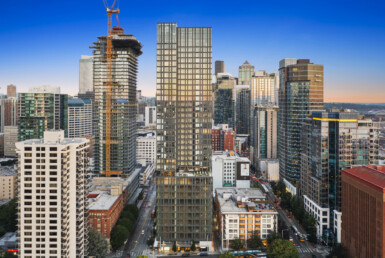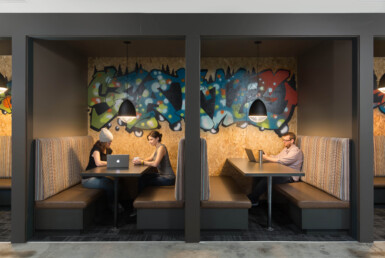How Energy Efficient Commercial Buildings Help Combat the Climate Crisis

Martin Selig Real Estate’ energy department is working to reduce energy use across the company’s portfolio
On the heels of the U.N. Climate Conference, we’re all more aware that individual actions do have an impact on the global environment. We pay a lot of attention to what we can do to make our homes greener, but we often overlook opportunities to reduce the footprint of our workplaces.
Yet commercial buildings use more than 40% of the total energy consumed in the United States, and 21% in Seattle, making them an easy target for energy reduction activities. And the American Council for an Energy Efficient Economy suggests reducing energy use could slash greenhouse gas emissions by 50% by 2050 and produce more than $700 billion in savings.
That’s why the City of Seattle included building energy efficiency in its Climate Action Plan (CAP), which focuses on reaching zero net greenhouse gas emissions by 2050. On the way to that goal, the City plans to reduce energy use in commercial buildings by 10% by 2030; so far the effort has saved three percent.
Martin Selig Real Estate (MSRE) is actively working to improve energy efficiency and reduce energy use across our portfolio of commercial real estate. Our newest project, 400 Westlake, will be the most sustainable commercial office building of its size in the world.
Making Commercial Buildings More Energy Efficient
Efforts to reduce environmental impact also include existing buildings. The MSRE energy department is upgrading and renovating several buildings as part of the City’s Building Tune-Ups program, which identifies opportunities to boost energy efficiency and reduce energy consumption. Thanks to these improvements, MSRE has achieved a total net savings of 1,332 metric tons of CO2 since 2018, the firm’s baseline year, and Executive Vice President Jordan Selig is looking forward to charting the firm’s progress as more projects roll out.
Our energy team has been installing LED lighting and adjusting heating, air conditioning and ventilation (HVAC) schedules to power down when buildings are unoccupied, dramatically cutting energy consumption and waste. These are critical tactics to reduce overall kilowatt hours (kwh) and energy use intensity (EUI), the amount of energy used per square foot.
Generating Results with Renovations
MSRE buildings at 635 Elliott, 3rd & Harrison, 5th & Yesler and the West Tower achieved Certified Energy Star scores high enough to be exempt from the Tune-Ups program.
The firm’s “biggest loser” is 3rd & Broad, where efficiency improvements have decreased energy use by 22% in one year and produced net energy savings of 71,922 kwh or about $7,552 of electricity. The building’s EUI is 48.2, which represents a 33.4% reduction between July 2016 and July 2019. Activities included changing the sequence of operation on the ventilation, cooling and water pumping systems; and installing LED bulbs in the parking garage, stairwells, restrooms and utility closets. Later this year, MSRE will install a modern building automation system here, which will create additional savings from the deployment of occupancy sensors that power down spaces that are not in use.
Similar renovations enhanced energy efficiency at these properties:
- 3131 Elliott Avenue: 20% kwh reduction or $5,694 of electricity
- 4th & Blanchard: 16% kwh reduction or $7,773 of electricity; 17.7% EUI reduction
- 1000 2nd Avenue: 14% kwh reduction or $6,942 of electricity; 17.6% EUI reduction
- North Tower: 14% kwh reduction or $840 of electricity
- 4th & Battery: 11% kwh reduction or $4,593 of electricity; 22.2% EUI reduction
- South Tower: 10% kwh reduction or $731 of electricity
- 3101 Western: 9% kwh reduction or $1,738 of electricity
MSRE’s efforts to lower energy use continue, with the recent approval for complete building tune-ups at 4th & Vine, 5th & Jackson, 3131 Elliott, 3101 Western, 333 Elliott and 645 Elliott. MSRE has also received alternate compliance approval on 1000 2nd Avenue, 3rd & Broad, 4th & Blanchard and 4th & Battery.
Ms. Selig is committed to showing the community that MSRE means business and is on board with the city’s aggressive goal to reduce greenhouse gas emissions. She also worked closely with the city to help draft the Living Building Pilot program to lower the local construction and transportation industry’s climate impact. These activities are part of MSRE’s overall approach to corporate social responsibility and its accountability to the Seattle community.
Reducing Energy Use at the Office
Beyond infrastructure improvements, there are many things individuals can do to reduce energy consumption at the office:
- Use task lighting instead of illuminating the entire space.
- Turn lights off when leaving rooms.
- Unplug office and break room items like lamps, fairy lights, teapots and toaster ovens when you leave for the day.
- Turn off electronics, computers and monitors at day’s end.
- Purchase Energy Star-rated appliances and fixtures.
- Avoid keeping the space too hot or too cold.
Get more tips on reducing energy use at your office from the U.S. Department of Energy.




